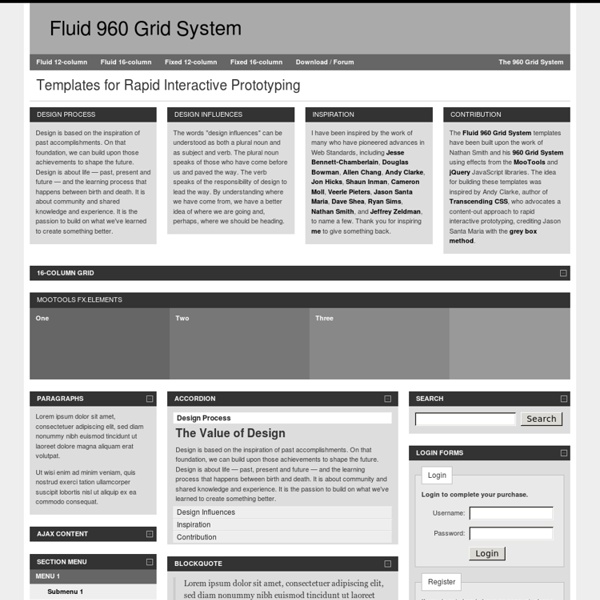Grid design basics: Grids for Web page layouts
By CraigGrannell Introduction Since tables were co-opted for layout purposes, columns have become key to many Web design layouts, and this thinking continued when CSS took over from tables (at least in the minds of savvy designers) for Web-page presentation.
Gui Prototyping Tools
Here is an alphabetical list of tools helping with drawing screen mock-ups. 10screens create and share clickable rich prototypes online, Now free as of July 2012 Allows multi-level drill-down of workflows to screens. Templates for various mobile devices with soft keyboard support Adobe FireWorks CS4 Adobe Flash Catalyst (former Thermo) production-ready version available in April 2010, as part of Adobe CS5 specialized tool, for interaction design create prototypes based on designers work (e.g. photoshop, illustrator files) Antetype - automatic layout - no more pixel pushing widget library (400+ pre-made) responsive web design - breakpoints, content wrapping, fluid designs interactions - clickthrus, mouse events wireframes, visual design, prototypes iOS Viewer web viewer OS X viewer Mac OS X only 30 day free trial - Examples and Inspiration : App Mockup Tools Get it now! Use VB for the demo. I think MS has some "crippled" versions for free.
Sample Workflows — Kepler
Kepler comes with a number of demo workflows that can be found in your KeplerData/workflows/module/outreach/demos directory. Highlighted here are two workflows from the demos/getting-started directory. Lotka-Volterra Workflow Author: Rich Williams, NCEAS
Building fluid grid layouts in Adobe Dreamweaver CS6
With the ever-increasing use of mobile devices, it has become necessary to design online content that appears on multiple screen sizes and a myriad of desktops, laptops, tablets, and smartphones. The challenge involves designing sites that adapt to fit a variety of different resolutions and use the available screen real estate effectively. Previously, these goals have proven to be time-consuming. Hand-coded media queries and complex mathematical calculations were often required to deliver online presentations with fluid layouts to reach the widest audiences. Adobe Dreamweaver CS6 introduces the Fluid Grid Layout feature to help make designing for multiple screens easier. Fluid grid-based layouts display content in containers that have widths set to percentages, which react proportionately to changes in screen sizes.
ARIS Express - Free Modeling Software
Download your free of charge copy ofARIS Express right nowDownload for Free now!Version 2.4 available since Dec 19, 2012 ARIS Express is free of charge Perfect tool for occasional users and beginners in Business Process Management Intuitive user interface − modelers can work productively from the start Models for organizational structures, processes, application systems, data, and more Free training material available in ARIS Community All results can be re-used and enhanced in professional ARIS Platform products
The Power of Wireframes and Mockups
by anthony on 08/17/10 at 8:16 pm In user experience design, there are a variety of deliverables that a typical UX designer generates. They can include personas, process flows, site maps, concept maps, heuristic evaluations, user scenarios, content inventories, and etc. While these deliverables are fashionable in their own way, there is one set of deliverables that outshine the rest. They are WIREFRAMES & MOCKUPS. These deliverables are the most important deliverables of all deliverables for the following reasons:
960 grid photoshop - Google Search
Advertisement Creating a grid is typically one of the very first things you do when starting a design comp. After all, it provides the basic structure on which the rest of your design will lie.
The Top 4 Sites To Find Free Printable Posters
We’ve talked about printing posters in the past, even reviewed multiple applications, like PosteRazor or Rasterbator, that can help you cut bigger posters up, and piece them together with regular-sized paper. Somehow we skipped the first installment; where to find suitable posters for printing? Google’s a good guess, but read on for MakeUseOf’s top 4 sites to find free printable posters. Movie Poster Archive Practically everyone has had a movie poster brandish his wall at some point in his life.
Taverna - open source and domain independent Workflow Management System



